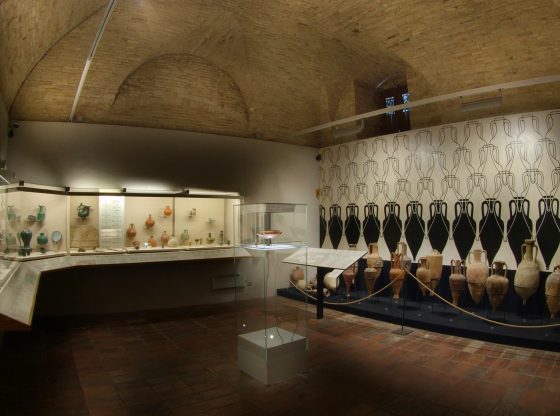Conceived and created by Giorgio Lungarotti and his wife Maria Grazia, the Wine Museum was opened to the public in 1974 and is now managed by the Lungarotti Foundation. It is located in Torgiano in the pars agricola of the monumental Graziani-Baglioni mansion, a 17th century noble summer residence.
The museum covers twenty rooms and displays more than 3000 pieces, organized according to modern museological criteria and rigorous scientific protocol.
Archeological finds (Cycladic jugs and Hittite vases; Greek, Etruscan and Roman ceramics; glassware and bronze pieces) technical equipment and sets for viticulture and vinification, ceramic wine vessels from the Medieval, Renaissance, Baroque and contemporary periods, engravings and drawings from the 15th to 20th centuries, prestigious antique books on viticulture and enology, artifacts of goldsmithery, weaving and other pieces representing the applied arts, all document the importance of wine in the collective imagery of the civilizations that over the millennia have lived in the Mediterranean basin and continental Europe.
Starting back in antiquity, the vine, grapes and wine, essential elements in the agricultural economy of these peoples, have alternated between purely economic values and the religious and secular traditions and meanings. From the most remote era to today, their recurrence in arts and crafts is constant, either as a symbol for inspiration or for productive reasons. The individual collections in the museum propose the theme of viticulture and Bacchus as a leitmotiv for reading the historical events which the individual pieces depict.
In the archeological section, the most interesting piece is the Kylix with an inscription signed by Phrinos, a member of the Group of Minor Masters, a lovely example of Attic ceramics, datable to the 6th century B.C. and the elegant Askós in bronze from the Vesuvian area, dating back to the 1st century A.D.
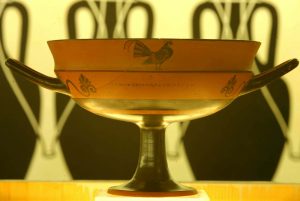
Sala I: “Le origini della viticoltura, l’uso e il commercio del vino in area mediterranea”
Phrinos, KYLIX
ceramica a figure nere con ritocchi
Vulci, metà VI sec. a.C. (inv.87)
The ceramics collection highlights one of the crafts that have most importantly characterized Italia’s artistic heritage; among the many pieces on display, all of which represent different schools and techniques, of particular note is the large 14th century hydria with a lion-shaped centaur and a two-tailed mermaid, as well as the pilgrim’s flask from Urbino, from the workshop of Orazio Fontana, whose ornate decoration includes a composition of subjects from Raffaello and Giulio Romano. In the display case with historiated Renaissance plates, the piece entitled L’Infanzia di Bacco/The childhood of Bacchus by Mastro Giorgio Andreoli is an outstanding part of the collection; it creates a pleasing match with the Bacchus crafted by Della Robbia.
In the section wine and medicine, apothecary vases – of various types and production areas – are matched with antique medical texts. The ceramics portion closes with a collection of modern works, among which are the Plate with Satyr by Jean Cocteau, Dionysos Eydendros by Joe Tylson and La Baccante by Nino Caruso.
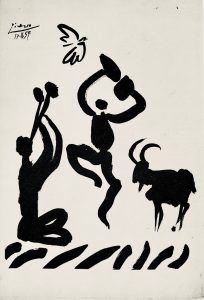
The engravings collection offers many points of interest: starting with a Bacchanalia by Andrea Mantegna (15th century) the collection shows the evolution of the dionysian theme between the 15th and 20th centuries.
The piece which emblematically represents vinification techniques is the imposing horizontal beam press from Gubbio using the so-called Caton principal, from the description made by this Roman agronomist in the 2nd-1st. century B.C.
Reviewed by the New York Times as “best in Italy” thanks to the quality of its artistic collections, the Wine Museum was appointed among the Top 10 Best Wine Museums of the world by the prestigious magazine The Drinks Business.
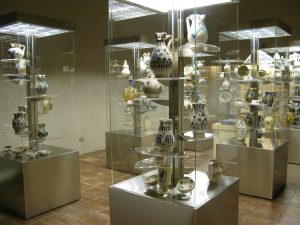
MUVIT Museo del Vino di Torgiano
Corso Vittorio Emanuele, 31 – 06089 Torgiano (Perugia)
tel: +39-075-9880200
fax: +39-075-9880300
e-mail: prenotazionimusei@lungarotti.it
www.lungarotti.it/fondazione/muvit
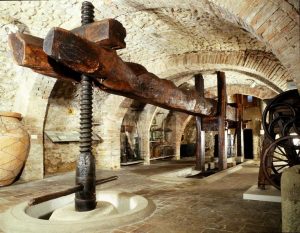
OPENING HOURS:
From October to March: 10am to 1pm / 3pm to 5pm; closed Mondays and December 25th
April, May, June: 10am to 1pm/ 3pm to 6pm; closed Mondays
July, August, September: 10am to 6 pm; open every day
Admission
Single ticket for MUVIT Wine Museum and MOO Olive and Oil Museum
Guided tours upon reservation in Italian, English, French, German, Russian and Spanish
Educational Workshops
Che ne dici di far parte del Club del Vino?
Abbiamo 3 opzioni di partnership, a partire da quella GRATUITA.
Per saperne di più, dá un’occhiata al link che segue:
>> Partnership con il Club del Vino <<
Cin-Cin!

